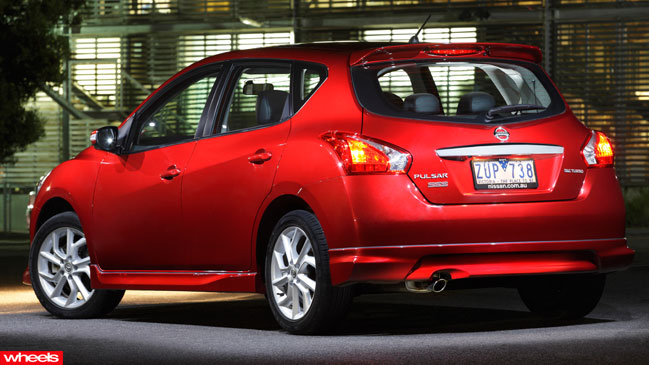Car companies love tapping into nostalgia. Invoking memories of a bygone hero is a shortcut to consumers’ wallets that potentially saves millions in advertising. Two recent examples of resurrecting the past are the Toyota 86 and Peugeot 208GTi – both largely successful, albeit to varying degrees.
This time it’s Nissan delving back 13 years to rejuvenate the SSS moniker to headline the Pulsar hatchback range launch. The hatch itself is integral to Nissan’s stated goal of topping Australia’s new- car shopping list, and the reborn SSS is clearly about adding some desperately needed panache to Nissan’s small-car portfolio.
The five-door Pulsar hatch joins a conservatively styled sedan that’s been stealing around 1500 sales a month from Mazda 3 and Corolla since February.
It’s not the 4000-a-month Nissan’s previous sales boss Ian Moreillen promised when Pulsar’s return was confirmed mid-2012. Straight to the top of the charts, he said. Best-selling car in Australia in its first year, he said. To be fair, the first year is not over, although Mr Moreillen’s stint as Nissan sales boss most certainly is.
Australians are a conservative lot, so the Pulsar sedan’s lacklustre styling isn’t necessarily holding it back, nor is a strong value equation, which the new hatch shares.
But given how poorly the sedan performed in Wheels June comparo, it’s clear real-world driving and dynamics aren’t good enough to beat the new and improved Corolla, let alone the deftly honed Mazda 3.
That could change with the arrival of a turbocharged 1.6-litre petrol engine that adds big punch to Pulsar’s allure. It’s a cracking engine that boasts a healthy 140kW and 240Nm, significantly more than the base 1.8-litre’s 96kW and 174Nm.
This turbo engine will power the upper half of the hatchback range, the ST-S and the SSS respectively; the cheaper ST and ST-L will make do with the 1.8. At this stage there are no announced plans to put the turbo engine in the sedan, or to do a SSS sedan.
Sadly, the new SSS is nothing like the legendary N14 or the N15 swansong of the 1990s, though it’s certainly faster in a straight line than those much-loved 105kW hot hatches.
Even putting aside expectations ignited by Nissan’s nostalgia push, the reborn Pulsar SSS simply isn’t good enough to be a hot hatch. Or even a warm one.
There’s no questioning the turbocharged engine’s credentials. It’s a punchy unit with plenty of urge, and revs enthusiastically until lights-out. Fairly economical, too, rated at 7.7L/100km. But the chassis in which the engine resides is as sporting as Eddie the Eagle. Or John Howard with a cricket bat.
Suspension that is tailored for the higher-output engine (firmer springs and dampers) does little to tame excessive bodyroll on turn-in and through corners, leaving the front tyres to scrabble like a dog on lino.
The steering is light and lifeless, and its turn-in bite is blunted by the bodyroll. About the only thing the Pulsar SSS does well is absorb bumps, but it’s obvious there’s suspension compliance to spare.
The SSS doesn’t claim to be a hardcore sports car. But with 140kW and SSS badging, it does claim to be a hot hatch. And reality doesn’t gel with that aspiration. It’s not dynamic or engaging. And it’s certainly not fun to drive.
Resurrecting a bygone hero is fine, providing the modern warrior is as true to the original in concept and execution as ever-tightening regulations allow. But sometimes companies don’t understand the appeal of the original and therefore stand little chance of reinterpreting it for the modern world.
Just because something can be reborn, Mr Rudd, doesn’t mean it should be. Like a double-edged sword, nostalgia cuts both ways.





